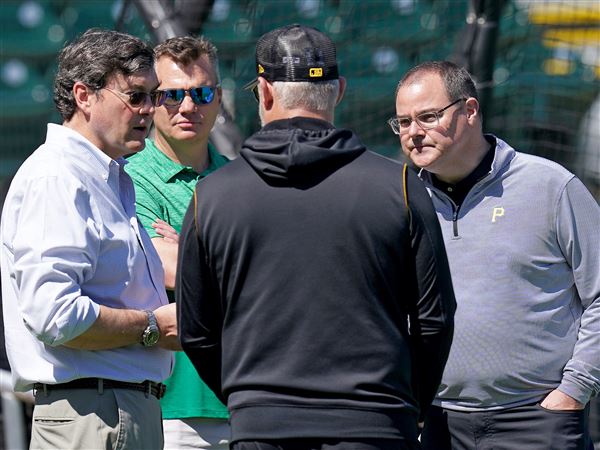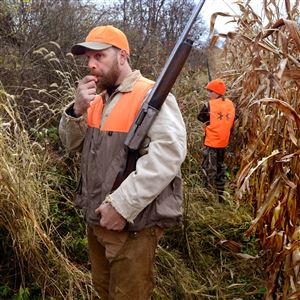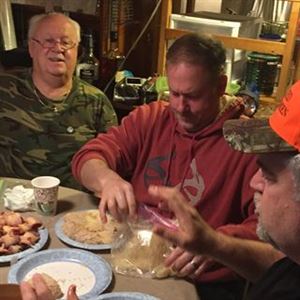Eric Bergfelt of Warrendale waited until the doe was at the right range and broadside to his position. He squeezed the trigger and sent a crossbow bolt through the soft muscle behind its shoulder.
It was another successful archery hunt last week in Allegheny County, another opportunity for him to teach his son Jacob, 7, about wildlife, hunting safety and more of the rural values passed through the Bergfelt family.
When the statewide firearm deer season opens Saturday morning, nearly a half million Pennsylvanians are expected to be wearing fluorescent orange. In addition to being the government’s primary tool for deer management, hunting is a long-standing tradition, a rite of passage among country folk and urbanites who embrace aspects of rural culture.
“My Pap taught me when I was young. Now that I have Jacob, I feel it’s my turn to teach him the values I was raised with,” said Mr. Bergfelt.
Pennsylvania’s topography and undergrowth naturally favor white-tailed deer. The state’s human population, fifth highest in the nation, adds 7.3 million acres of agriculture and countless backyards sprouting an ideal year-round deer diet.
Hunters in only two states, Indiana and Tennessee, harvest more deer than Pennsylvania, where 422,960 were taken in the 2022-23 seasons. More deer are killed by hunters than any other cause, and more are taken on the first day of firearms deer season than any other day.
“[It is] truly a tradition unlike any other,” said Bryan Burhans, executive director of the state Game Commission.
“We’ve got lots of deer and lots of hunters pursuing them, some from camps far from home, others in woodlots and fields near where they live. But all share the same passion for wildlife, hunting and conservation. That’s something special.”
Although hunting is no longer needed to acquire food, it is overwhelmingly supported by the American public. Responsive Management, a Virginia-based research firm specializing in natural resources and outdoor recreation issues, reported in 2019 that about 4% of the population hunts while some 80% generally support legal hunting even if they don’t participate.
“It seems counterintuitive that hunting, an activity in which so little of the population participates and that which is no longer critical to survival, would enjoy such widespread, contemporary approval,” said the report. “Nonetheless, social science research clearly confirms this support.”
It starts, said Responsive Management, with family.
“Research also consistently shows that it takes a hunter to make a hunter, meaning almost all hunters today were initiated into hunting by another hunter, usually by a father or father figure.”
"Our hunter surveys have shown about one-third of hunters who head afield do so with the primary motivation of spending time with friends and family," said Game Commission spokesman Travis Lau.
Family members teach newcomers basic skills, provide the gear they need afield — often hand-me-downs from another generation — and give them the opportunity to experience success.
"Think about how important those things are to the whole," he said, "and how much more difficult it is for a new hunter to get started if they don't have that type of family support."
Pulling the trigger is a small part of hunting. Hunting is a small part of conservation, said Mr. Bergfelt.
He describes it as an understanding of how nature works and the human role in compensating for disruption of natural processes. He wants his son to learn at a young age the Bergfelt way of understanding nature, building family ties, developing interpersonal relationships and taking responsibility, all of which he believes can be learned through working together while hunting.
Mr. Bergfelt was 5 when his grandfather started taking him shooting, 13 or 14 when he went on his first hunt.
“My Pap was the one who was into all that,” said Mr. Burgfelt. “It wasn’t something he forced upon me. We moved to Warrendale [from Pittsburgh] and I met people out here who hunted. It was something I wanted to do.
“When I told [Pap] I was interested, a side of him changed. I could tell he wanted me to do it without saying it. He wanted to pass that tradition to me.”
Now, said Mr. Bergfelt, it’s his turn.
From a young age, Jacob liked eating venison and was interested in his father’s stories about where the food came from. Warm weather walks in the park “became our thing.”
“I slowly started integrating him out in the woods with me,” said Mr. Bergfelt. “I took him out for an hour while hunting or fishing. I just wanted to instill in him all the family values that I was taught.”
Jacob learned where to point the muzzles of his toy Nerf gun and Orbeez gel blaster – “the safe end and the dangerous end.” He got his first firearm at 5, a bolt-action single shot .22 caliber Crickett, a small light kid-size rifle.
“That’s how I learned,” said Mr. Burgfelt. “I started with a single shot .22 and then a single shot 12 gauge. It’s the safest way to learn.”
Jacob was 6 when he began accompanying his dad on trips to the firing range. A first-grader at Marshall Elementary, Jacob said spending time with his dad outdoors is one of his favorite things.
“I’ve been doing it since I was little,” he said. “We walk around with our dog outside. We go and shoot sometimes. I love my family and being with my dad.”
Mr. Bergfelt said he and Jacob will stay home Saturday. In two weeks, when firearms season is over and target shooting reopens at state-run firing ranges, they’ll go shooting. It won’t be long, he said, until he takes Jacob on his first hunt.
“He’s still a little too young to hunt,” he said. “It’s a maturity level. As a parent you can tell.”
The Pennsylvania General Assembly leaves it to parents and caregivers to decide how old is old enough for hunting.
Under the mentored hunting program, kids age 7 and older can legally hunt but with many stipulations. Thirteen big and small game species including deer may be hunted, but not waterfowl.
Youth hunters must be accompanied by a mentor who is at least 21 years old and in possession of a valid adult hunting license. The young hunter must be stationary while in possession of a lawful sporting arm. Those under 16 must be within arm’s reach of the mentor; mentored youth age 17 and older must be within the mentor’s sight and hearing range.
The pair cannot be in possession of more than one sporting arm. The mentor has to carry the gun while moving and may not be accompanied by anyone but a single mentored youth. The mentor is accountable for all actions of the mentored hunter while engaged in hunting or related activities.
New hunters age 12 and older have to pass the Game Commission’s Hunter-Trapper Education course. It’s not uncommon for family members to accompany kids to the classes. Most certified hunters ages 12-16 can obtain a junior hunting license.
The demographics of hunting are changing. Nationwide, more females and non-white hunters are buying licenses, and while food continues to be a motivation, learning under the guidance of mentors naturally includes an appreciation of their traditions dating back generations.
“I think it’s because you [learn from] people whose families gave them certain values and they rub off,” said Mr. Bergfelt. “It becomes part of the learning, and the tradition continues.”
John Hayes: jhayes@post-gazette.com
First Published: November 24, 2023, 10:30 a.m.
Updated: November 25, 2023, 3:15 p.m.



















